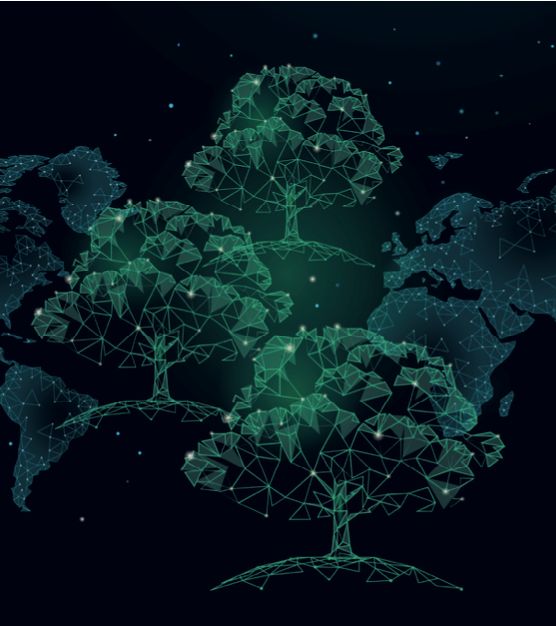To meet the world’s environmental challenges, leaders must radically reimagine their organizations.
As environmental challenges grow, organizations are stepping up their sustainability efforts. But traditional hierarchical structures – with rigid chains of command and linear processes – struggle to address complex, interdependent issues like climate change and resource depletion. A sustainable future requires a reimagining of organizations as networked ecosystems: structures that mirror the interconnectedness of life itself.
By adopting network-based structures, businesses can align with the principles of circularity, resilience and interdependence. This shift allows them to operate as integrated parts of a broader environment, fostering a mindset essential for true sustainability.
Hierarchies: a barrier to sustainability
Conventional organizations prioritize efficiency, predictability and control – principles that have long driven economic growth, but also perpetuated environmental degradation. The linear ‘take-make-waste’ model incentivizes short-term gains over long-term ecological balance. Siloed functions and rigid reporting lines hinder collaboration and the flow of information, limiting organizations’ ability to tackle sustainability challenges holistically.
What’s more, in traditional organizations, sustainability initiatives are often confined to specialist departments, disconnected from the core strategy. As a result, improvements tend to be incremental, falling short of the systemic transformations that are so badly needed.
Networks: a new paradigm
Network science – sometimes called the science of the 21st century – offers a new way to think about organizational design. It reveals a consistent truth: all complex systems, including businesses, are structured around network patterns.
Networked organizations operate as dynamic, interconnected systems, mimicking natural ecosystems. Unlike hierarchies that centralize authority and restrict communication to the boundaries of their silos, networks distribute decision-making and foster cross-functional collaboration. They thrive on shared purpose, adaptability, and rapid knowledge exchange. Their decentralized structure enhances resilience.
Leading organizations – including Assa Abloy, Bosch Power Tools, Fujitsu Europe, Microsoft, Patagonia, Pixar and Spotify – are already applying network principles. These companies show how interconnected systems are particularly well suited to driving both innovation and sustainability. By mirroring the interdependence of natural ecosystems, network structures encourage collaboration and resource sharing, helping reduce waste and inefficiency.
Interface, a global leader in modular flooring, is a standout example. Through its Mission Zero initiative, the company achieved net-zero carbon emissions in 2019 (including supplier emissions). It aims to become fully circular by 2040, embedding regenerative practices across its operations.
As network science shows, biological, social and technological systems all thrive through connectivity. Organizations that adopt this mindset are better equipped to make sustainability an integral part of their operations.
Circular systems: a networked approach
The circular economy is one of the most powerful applications of network thinking. Instead of depleting resources and generating waste, circular systems mimic nature’s regenerative cycles by keeping materials in use. Three benefits stand out. First, such systems minimize resource depletion: reuse, recycling, and repurposing reduce demand for new resources. They close the loop, by turning waste from one process into input for another, creating self-sustaining cycles. And they drive innovation through the development of new materials, processes and business models.
Networks expand the impact of circular systems by connecting stakeholders across industries, fostering collaboration along value chains. By creating ecosystem synergies, networks transform waste from one organization into a valuable resource for another, enhancing sustainability. Decentralized leadership within circular networks empowers multiple actors to take ownership of sustainability efforts, ensuring collective success.
An example is the Ellen MacArthur Foundation, which convenes businesses, academics and governments to shift from linear to circular models. A key partnership with Ikea is helping the brand adopt circular design principles, aiming for fully circular operations by 2030 with products designed to be reused, repaired or recycled.
Another is the Kalundborg Symbiosis in Denmark, which showcases industrial ecosystem collaboration. Power plants, pharmaceutical firms and agricultural producers share excess heat, steam, water, gypsum and sludge. This drastically reduces waste, cuts costs and lowers carbon emissions. It shows that industrial ecosystems can function as closed-loop systems, to the benefit of both businesses and the environment.
Organizations as part of the environment
Adopting a networked perspective also shifts how organizations see their role in the world. They are no longer isolated entities but parts of a larger web – both socially and environmentally. This shift has profound implications.
Interdependence Organizations recognize their reliance on healthy environmental and business ecosystems, leading to more responsible decisions
Systems thinking Leaders adopt holistic views and consider the ripple effects of their actions
Regeneration Organizations move beyond minimizing harm to actively restoring environmental ecosystems.
This mindset demands a new kind of leadership – one that embraces uncertainty, supports collaboration, and prioritizes long-term outcomes over short-term wins. Of course, the transition to networked ecosystems requires more than intention. It demands structure, tools and action. Start with these seven steps.
1. Adopt network leadership Shift from command-and-control to facilitation and empowerment across the organization
2. Embed purpose Align organizational goals with environmental stewardship and social impact
3. Foster a learning culture Encourage curiosity, experimentation and open dialogue
4. Leverage digital tools Use digital tools to enhance transparency and collaboration
5. Invest in organizational network analysis (ONA) Map and understand information flow, relationships and influence
6. Rethink measurement Go beyond traditional metrics to assess ecological footprint and resource efficiency
7. Build circular partnerships Partner across industries to develop circular supply chains and share resources
A fundamental shift
Sustainability challenges are forcing a rethink of how organizations are structured and operate. The future is being built not through hierarchy, but through networks. When sustainability is integrated with network principles, it not just an ethical imperative, but a strategic advantage.
The future of sustainability depends on an interconnected perspective, where organizations function as living networks within ecosystems. The time to initiate this shift is now.



